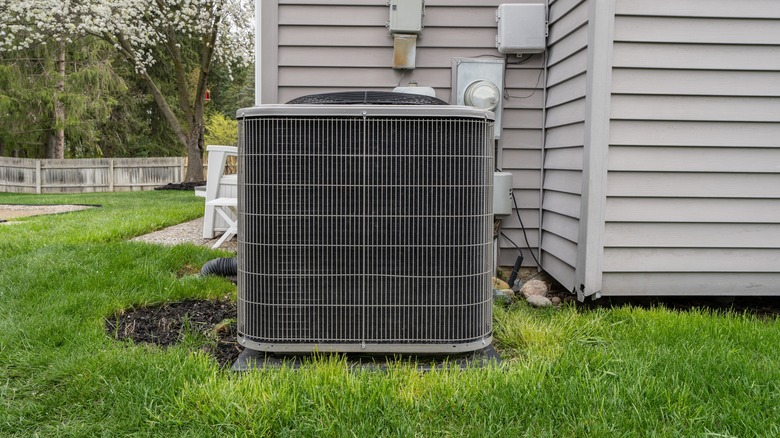How To DIY A Stylish Fence To Cover An Unsightly HVAC Unit
When TikTok DIYer Greg Navage (@thenavagepatch) set out to build a screen to hide his backyard HVAC unit, electrical service entry, and other mechanical and utility doodads, he thought that "privacy screen" was a "fancy name for a very short fence." What he ended up building instead was a fairly tall privacy fence in stained cedar and black trim, a popular color combo for mid-century fences everywhere. It's a great DIY project that almost anyone can do with just a few basic tools. You can also make a simpler DIY screen for your AC unit using wooden pallets.
This stained natural wood with vertical black trim is the classic mid-century layout and color scheme. If you want to accentuate the mid-century feel of the design, there are lots of approaches that would work. Use thinner and uniform slats, or space them farther apart and connect them between the slats at even intervals. Run a few rows of very narrow slats at the top, or gradually increase the width of the slats from top to bottom. You could also make the slats vertical if that works better with your home than a horizontal fence, but it will have less of a mid-century sensibility and require a little more structure to support. Dark gray or even black slats should work for the mid-century feel. Also, it doesn't have to screen your AC. Dave and Jenny Marrs used a similar approach to keep a client's front porch private, and you can even use this fence and other techniques to keep your entire yard private.
How to make the DIY privacy fence for your HVAC unit
As we said, this DIY project is about as simple as they come. The fence is designed in panels, the width of which is probably driven by the length of the cedar planks he used. Navage first set the 4-by-4 posts at the corners and at every panel width between. He leveled the posts, cemented them in with fast-setting concrete mixed with a gravel aggregate, then checked them for level again. Before moving on the fence panels, he primed the pine posts with an oil-based primer and painted them black. To protect the fence posts from rotting, you can cap them and apply stain or protective chemicals, or even use plastic sleeves to protect the below-ground portion of the posts.
The cedar boards — perhaps fence pickets — had a "furry" finish, so Navage ran them through a planer for a smooth surface. He then leveled and clamped the first board into place at the top of the fence. He pre-drilled holes for the decking screws used to attach the slats to the posts, then worked his way down the panel, using a cedar board as a ½-inch spacer. He stained the cedar to accentuate its color and grain. He finished up by making an L-shaped corner trim from leftover cedar, which he painted black to match the posts.
Dress up your fence as you see fit. A matching planter box in front of the fence wouldn't go amiss. You can also hang planters from the spaces between the slats to add a little warmth without losing the MCM vibe.
